Happy 246th Birthday to the US Navy!

The U.S. Navy turns 246 years old today. On October 13, 1775, the Continental Congress commissioned two ships, each with eighty sailors, “for intercepting such transports as may be laden with warlike stores and other supplies for our enemies.” The foe at the time was Great Britain, whose navy ruled the seas. By the end of the Revolutionary War, the Continental Navy had grown to about fifty ships. In 1789, the U.S. Constitution guaranteed the navy’s future by granting Congress the power “To provide and maintain a navy.”
George Washington once said it is “as certain as that night succeeds the day, that without a decisive naval force we can do nothing definitive—and with it, everything honorable and glorious.” Those words are even more appropriate in the twenty-first century when U.S. interests span the globe. To serve and protect those interests, the U.S. Navy today has 294 deployable ships, 66 submarines, more than 3,700 operational aircraft, 347,487 active duty personnel, 96,710 reserve personnel, and more than 281,00 civilian employees.
More on:
John F. Kennedy was the first navy veteran elected president. But five of the next six presidents also served in the navy: Lyndon Johnson, Richard Nixon, Gerald Ford, Jimmy Carter, and George H.W. Bush. Well-known navy veterans include baseball Hall-of-Famers Yogi Berra and Stan Musial; basketball Hall-of-Famers David Robinson and John Wooden; football Hall-of-Famer Roger Staubach; pro wrestling great and former Minnesota governor Jesse Ventura; actors Humphrey Bogart, Henry Fonda, and Jack Lemmon; former Tonight Show host Johnny Carson; talk show host Montel Williams; musicians John Coltrane, and M.C. Hammer; and astronaut Neil Armstrong.
I asked Captain William A. Patterson, a naval officer spending a year as a visiting military fellow in CFR’s David Rockefeller Studies Program, what books and movies he would recommend for anyone wanting to learn more about the navy. Here are his suggestions:
Ian W. Toll. Six Frigates: The Epic History of the Founding of the U.S. Navy (2006). Toll tells the history of the beginning of the U.S. Navy through the stories of six frigates: the USS Constitution, USS President, USS United States, USS Congress, USS Constellation, and USS Chesapeake. It’s a fascinating look at the first build-up of U.S. military power following the post-Revolutionary War drawdown.
James D. Hornfischer. Neptune’s Inferno: The U.S. Navy at Guadalcanal (2011). The Battle of Guadalcanal was the start of the U.S. offensive campaign in the Pacific in World War II. Unlike the earlier Battle of Midway, Guadalcanal’s naval battles were a series of hard-fought actions over many months. It’s a great story of grit and determination that culminated in a U.S. victory. Japanese forces would be in retreat for the remainder of the war.
Clay Blair Jr. Silent Victory: The U.S. Submarine War against Japan (1975). Blair offers a comprehensive history of the U.S. submarine force’s operations in the Pacific theater during World War II. United States submariners view World War II as the crucible event that created the legacy of our force. U.S. submarines carry Silent Victory as the authoritative reference to that legacy.
More on:
Rear Admiral Richard H. O’Kane. Wahoo: The Patrols of America’s Most Famous World War II Submarine (1987). This is the story of the submarine USS Wahoo and its legendary captain, Dudley “Mush” Morton, as told by his second in command, Medal of Honor recipient Dick O’Kane. Morton’s aggression and tactical innovations quickly improved the effectiveness of the U.S. submarine force against the Japanese. For a different perspective, read Forest J. Sterling’s Wake of the Wahoo: The Heroic Story of America's Most Daring WWII Submarine, USS Wahoo. It tells the same story, but from the perspective of an enlisted sailor, Chief Forest Sterling, who served under both O’Kane and Morton.
Captain Patterson also recommended three films to watch:
Tora! Tora! Tora! (1970). This is the epic story of the Pearl Harbor attack told from both the American and Japanese perspectives. It’s an instructive look into how failure to keep up with an evolving security challenge can have catastrophic consequences.
Das Boot (1981). The movie follows a single German U-boat patrol in World War II. Although the boat is German, the stresses placed on submariners during war patrol were universal across countries and theaters. Das Boot is the best portrayal of those stresses.
They Were Expendable (1945). Robert Montgomery plays John Brinkley, a fictionalized character mirroring the exploits for which Vice Admiral John D. Bulkeley received the Medal of Honor. Bulkeley commanded Motor Torpedo Boat Thirty-Four (PT-34). His resourcefulness and ingenuity allowed his undersized boat and its squadron to cause significant damage to the enemy and to extract General Douglas MacArthur from Corregidor following the Japanese conquest of the Philippines.
Anna Shortridge and Margaret Gach assisted in the preparation of this post.
 Online Store
Online Store